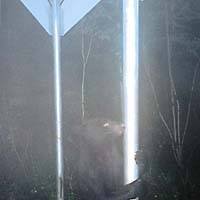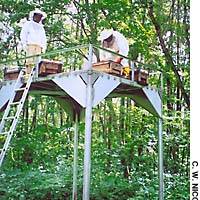This story is really about honey, a spoonful of which I have in my morning tea. Without it the day just doesn't seem to go right. Together with my old friend Mr. Shimada, I've been producing the finest honey for the last 20-odd years. However, first I have to tell you about my lovely "false acacia" trees. (What a horrible name; I'll just call them "acacia" for the rest of the story.)
Here in Kurohime, amid the hills and mountains of Nagano Prefecture, apart from our Afan Woodland Trust, we have a plot of land, half of which is used for farming, the other half being a patch of mixed woods. The land was very boggy when I first bought it, so I put in two long drainage pipes, 150 cm deep, set and buried in gravel, with soil on top. This drained into a small pond.
The trouble was that so much water came out it made a stream that flowed onto my neighbor's land. To remedy this I dug another, swimming pool-sized pond to take the water, the excess of which I could drain elsewhere without bothering anybody. Because the pond was deep, I planted cherry, horse chestnut and acacia trees on its banks. Thorny acacia grows quickly, and dissuades most people from venturing close to the edge of the water. Acacia has a lovely fragrant white blossom, which is excellent for honey. The trees I planted 20 years ago have become a fine grove now, all around the pond and along two sides of the field.
In the field we grew all kinds of things: potatoes, sweet potatoes, yams, daikon radishes, onions, leeks, cabbages, tomatoes, cucumbers, bitter Okinawan cucumbers, eggplants, carrots, melons, watermelons and pumpkins. However, we have pretty well given up on sweetcorn. The tsukinowa-guma (Selenarctos thibetans; Himalayan black bears) love sweetcorn, and their appetite for it is reinforced by local farmers who plant it year after year after year in the same place.
For the past few years we have also raised pigs on this patch of our land, fencing off an area about the size of a couple of tennis courts, plus the pond, so they can run free and also wallow happily in the water. Eventually I'd like to increase the number of pigs, as our ham and bacon is in demand, and include some woodland for them to roam in and root around. Then we'll rotate land use: pigs; vegetables; fallow; and so on.
Together with my old friend Kunio Shimada, we also keep bees. Matsuki-san, our woodsman, also keeps bees and has been trying his best to encourage wild Japanese bees. In early spring he had four hives going in the Afan Woodland Trust. Matsuki-san has tried all manner of strategies -- barbed wire, cages, all kinds -- trying to defend his hives against bears. Alas, all have failed.
I, too, want to be able to keep bees in the woods, so I designed a metal platform and got a local construction firm to build it. The platform has smooth, strong metal poles that I thought bears would not be able to climb, because when they climb trees they always dig in with their claws. As they can't dig their claws into thick, smooth metal, I was sure the platform would be bear-proof.
The platform was erected in the patch of woods beside our market garden and acacia grove, with hives placed on top in time for the acacia blooms. The bees seemed to approve of their new home, and busy indeed they were, buzzing to and from the acacia flowers, filling their little tummies with nectar, making waxy combs, fanning off the excess water, and making lots and lots of fine honey.
Knowing that it wouldn't be long before a bear scented the honey and came to raid, and wanting evidence to show that my platform was bear-proof, I asked Kenji Minami to set up a camera that is triggered by a movement sensor.
Well, I'm not really sure of the results so far, because we lost one hive. Photographs show a bear gripping the poles in a bear hug and wriggling up like a maggot. Muddy marks on one pole show that a bear got close to the top, managed to hook and tumble one hive, then fell off.
Since then the camera has recorded several more attempts, but we've not lost any more hives, and no bear has yet managed to get on top and wreak the usual havoc. Next acacia season I'm thinking of using a sensor that will not only trip a camera but also let an electric current pulse through a couple of wires close to the top of the platform. They should be set so as to zap a bear's nose as it gets close to the top.
If indeed I can succeed in making a bear-proof hive platform, it could also be used at other times for a bird- or animal-watching hide, or even as a camping platform. These platforms can easily be dismantled and shifted. You only need a strong set of four concrete bases into which the poles are slipped.
In Japan, the best horse chestnut trees are in bear country -- natural mixed forest. These trees really make the finest honey. One large tree can give you 10,000 yen to 15,000 yen of honey each year. I figure that this would be a way to make income from woodland.
If the platform really works, I plan to go before our trust's board of directors with a plan to set up another platform in the Afan Trust woods and gather evidence and data to try to persuade others to try it. The Forestry Agency, or perhaps even the Environment Agency, could make a little money renting them out.
Honey bees very rarely bother people unless they mess with the hives, and with the hives being up on a platform the general public will be perfectly safe.
As it is, we can easily sell honey and never have enough to meet our demands.
So here's to you, Winnie the Pooh!
Editor's note: During a recent "working lunch," Old Nic triumphantly announced he'd finally solved his bears-love-honey problem. "I'm going to grease the f***ing poles," he declared, Archimedes-like. A hive-tech solution, perhaps?





















With your current subscription plan you can comment on stories. However, before writing your first comment, please create a display name in the Profile section of your subscriber account page.